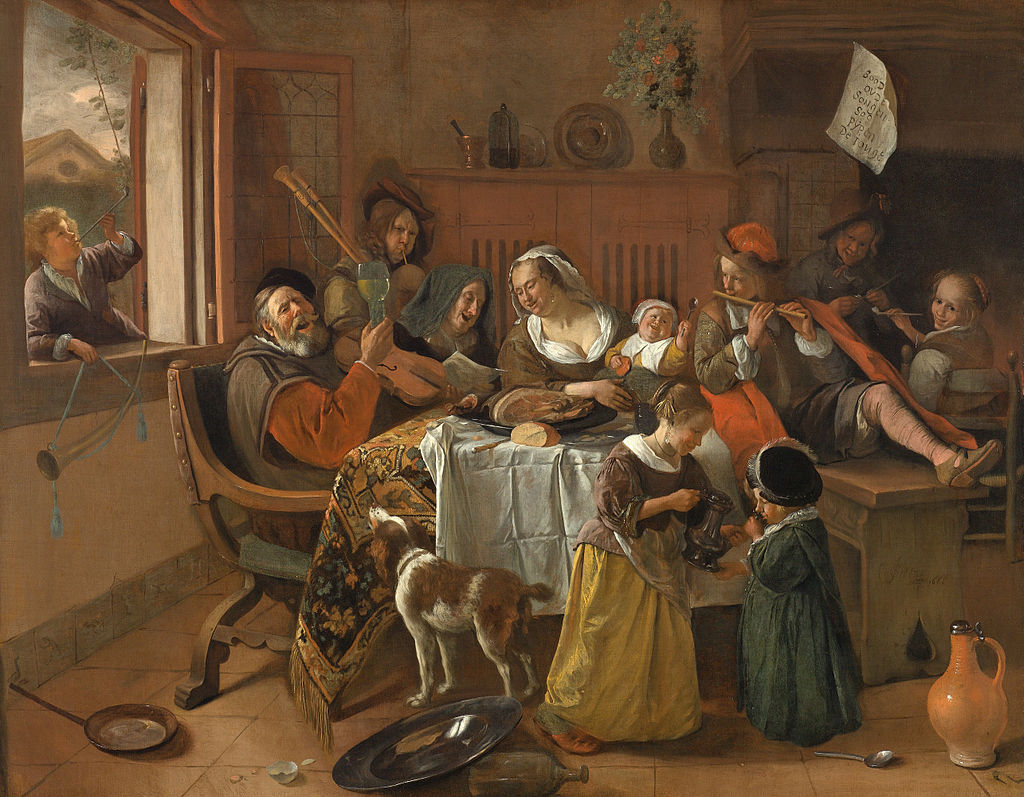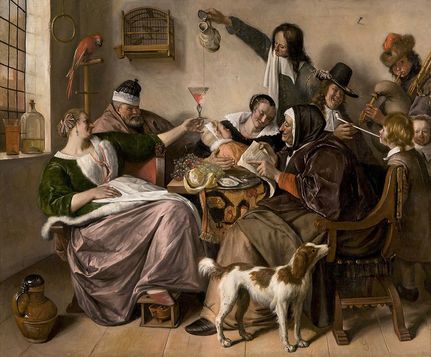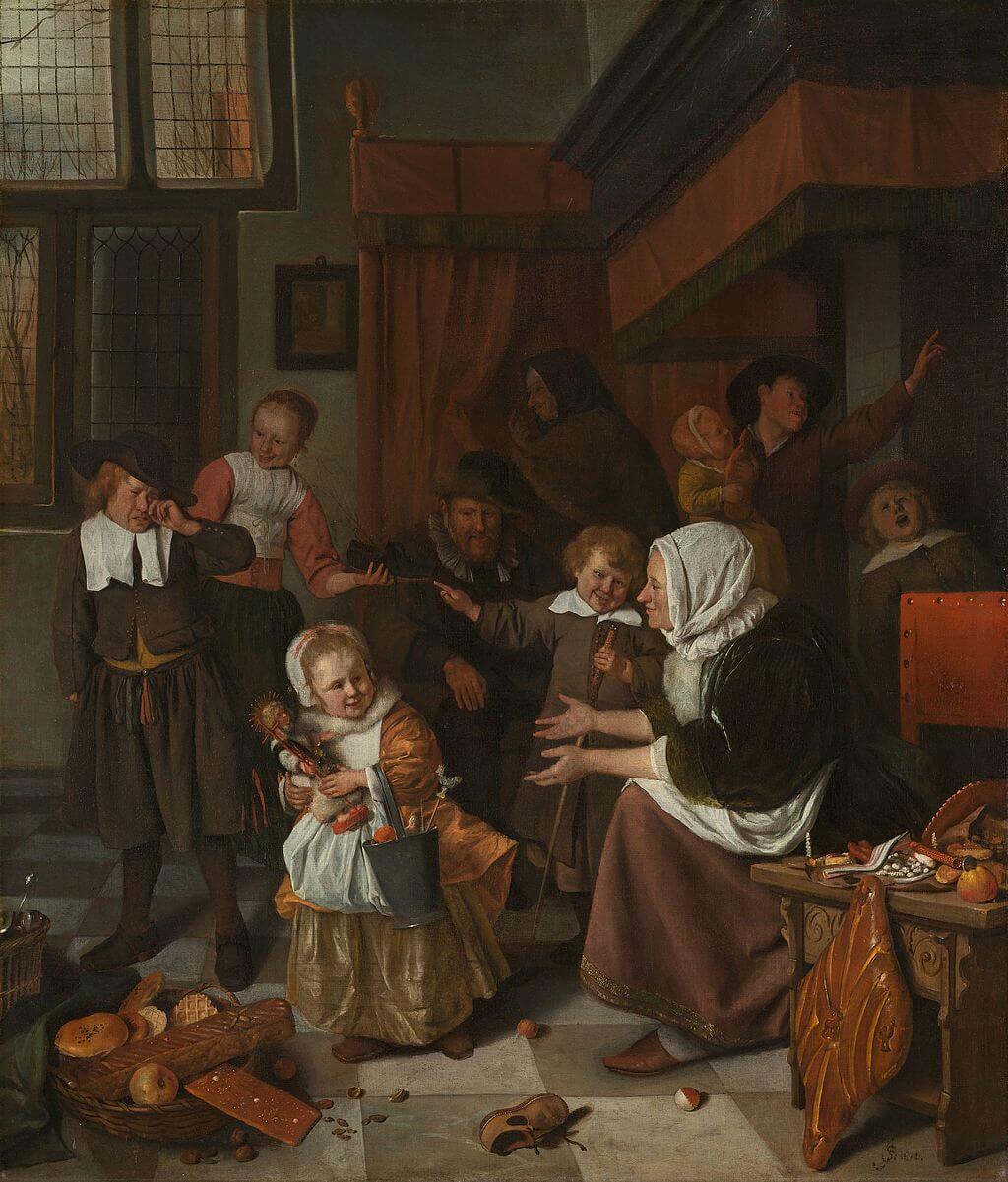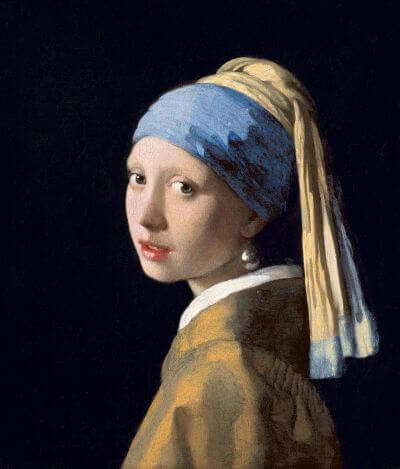|
Where? The Eregallerij on the second floor of the Rijksmuseum
When? 1668 What do you see? A happy household in a messy living room. The mother is sitting in the middle of the table and holds a young child on her lap. She is singing with her own mother next to her and shows a large amount of cleavage. The father on the left of the table is singing loudly as well and raises his glass while holding a violin in his left hand. The boy outside the window is smoking a pipe while he is holding a horn in his right hand. In the foreground, the young boy in green is drinking wine, which is provided to him by his sister who is holding a jug of wine. Both of them look older than their height would indicate. Two other children are playing music. The boy on the right with the red hat is playing the flute, and the boy in the left background is playing a kind of bagpipes. On the right background, a boy and a girl are holding pipes with tobacco. The dog is standing in front of the table which is filled with bread and meat, and he hopes that some of the food will fall off. The floor in the living room is messy, and we can identify a frying pan, half an eggshell, a large bowl, two jugs and a spoon. In contrast, the objects on top of the painting are neatly organized. On the top right, Steen included a piece of paper stating: ‘“Soo d’ oude Songen, Soo Pypen de Jonge.’ This means ‘As the Old Sing, So Pipe the Young.’ Backstory: Jan Steen sometimes used his own family as models for some people in his paintings, and it is suggested that some of the children in this painting are modeled after his kids. Steen created quite some paintings of families or groups of people in a messy environment. These paintings were not necessarily a realistic depiction of life in The Netherlands during the 17th century, but for Steen, it was a way in which he could include his style of humor and irony, but still provide a moral message. For example, some comparable paintings to The Merry Family are As the Old Sing, So Pipe the Young in the Mauritshuis in The Hague and The Feast of Saint Nicholas in the Rijksmuseum.
Moral message: Steen usually included a moral message in his paintings and he more often used children to convey this message. The behavior of the children in this painting is not intended to make you laugh, but to make you evaluate the behavior of their parents.
The message written on the piece of paper emphasizes that as it mentions that children are just copying the behavior of their parents. This message refers to the behavior of both parents and the grandmother, but primarily to the mother as, during that time, she was the main responsible for the moral values in the family. So, the moral message of this painting is that the people should be careful in the way they behave as it may have a big impact on (their) children. Who is Steen? Jan Havickszoon Steen (1626-1679) was born in Leiden in The Netherlands. During his life, he lived in various other Dutch cities, including The Hague, Delft, Warmond, and Haarlem. While Jan Steen also painted biblical, historical, and mythological scenes, his most popular works are the scenes from daily life. Steen is known for his humoristic style of painting, and he often included a moral message in his paintings, sometimes based on proverbs from his time. He is also considered to be an expert in accurately incorporating light into his paintings. While Steen has not had any known pupils, two of his sons were painters, but none of their works have survived. Fun fact: In Dutch, there is an expression for a messy and cluttered interior, which is still used nowadays. The Dutch expression is ‘een huishouden van Jan Steen’, which means ‘a Jan Steen household’. The people living in such a household are often depicted as happy people, just like in this painting. Jan Steen created quite some paintings that show these messy scenes, either depicting a family household in the living room or a group of people in a tavern. Jan Steen's messy households are in stark contrast to the very calm and organized paintings by his contemporary Johannes Vermeer, known of paintings such as Girl with a Pearl Earring in the Mauritshuis and The Milkmaid, which is also in the Rijksmuseum.
Written by Eelco Kappe
References:
1 Comment
|
Categories
All
|
- Home
- Blog
-
Museums
- Alte Pinakothek
- Art Institute of Chicago
- Baltimore Museum of Art
- Barber Institute of Fine Arts
- Bargello
- Barnes Foundation
- British Museum
- Church of Sant’Anastasia
- Cleveland Museum of Art
- Courtauld Institute of Art
- Detroit Institute of Arts
- Frans Hals Museum
- Galleria Borghese
- Gallerie dell'Accademia
- Getty Museum
- Guggenheim
- Hermitage Museum
- Kunsthistorisches Museum
- Kunstmuseum Basel
- Legion of Honor Museum
- Louvre
- Mauritshuis
- Metropolitan Museum of Art
- Musee d’Orsay
- Museum of Fine Arts in Boston
- Museum of Modern Art
- National Gallery in London
- National Gallery of Art
- National Museum in Poznań
- Norton Simon Museum
- Ny Carlsberg Glyptotek
- Palace of Versailles
- Palazzo Pitti
- Palazzo Vecchio
- Petit Palais
- Philadelphia Museum of Art
- Prado
- Pushkin Museum
- Ravenna Art Museum
- Rijksmuseum
- San Diego Museum of Art
- Santa Maria delle Grazie
- St. Peter's Basilica
- Städel Museum
- Statens Museum for Kunst
- Tate Britain
- Tate Modern
- Timken Museum of Art
- Uffizi
- Vatican Museums
- Wallace Collection
-
Artists
- Altdorfer
- Anguissola
- Berlin Painter
- Bosch
- Botticelli
- Boucher
- Bronzino
- Bruegel the Elder
- Brunelleschi
- Cabanel
- Caillebotte
- Canova
- Caravaggio
- Carpeaux
- Cezanne
- Cimabue
- David
- Degas
- Delacroix
- De Maria
- Donatello
- El Greco
- Fontana
- Fra Angelico
- Fragonard
- Gauguin
- Gentileschi
- Gericault
- Gonzalez-Torres
- Goya
- Hals
- Hogarth
- Hokusai
- Ingres
- Leonardo da Vinci
- Lippi, Filippo
- Longhi, Barbara
- Lorrain
- Makovsky
- Manet
- Massys
- Matisse
- Merian
- Michelangelo
- Mochi
- Modigliani
- Monet
- Panini
- Parmigianino
- Perugino
- Picasso
- Pisanello
- Raphael
- Rembrandt
- Renoir
- Reynolds
- Rivera
- Rodin
- Rubens
- Scultori
- Seurat
- Steen
- Tintoretto
- Titian
- Toulouse-Lautrec
- Turner
- Uccello
- Van der Weyden
- Van Dyck
- Van Eyck
- Van Gogh
- Van Hemessen
- Vasari
- Velazquez
- Vermeer
- Veronese
- Vigée Le Brun
-
Locations
- Books
- About Us





